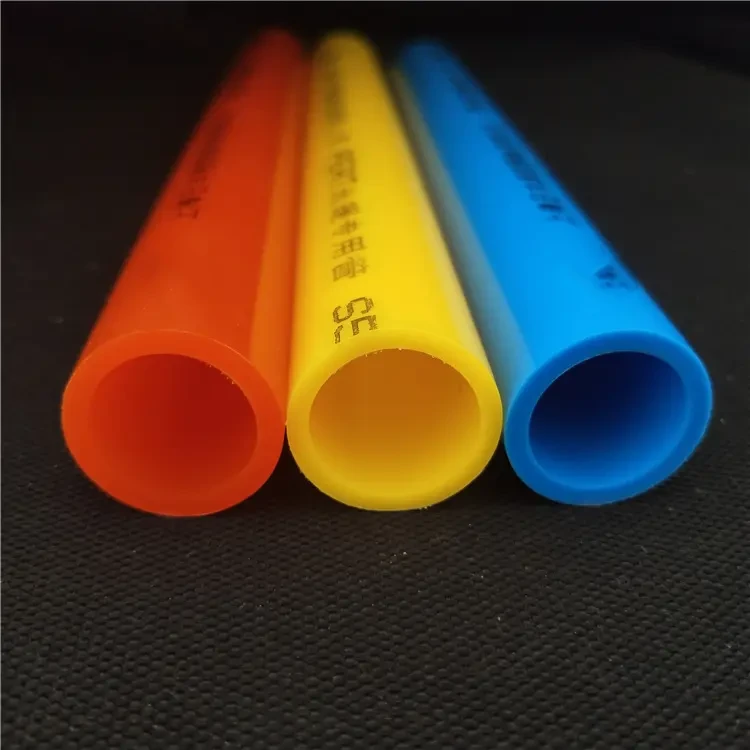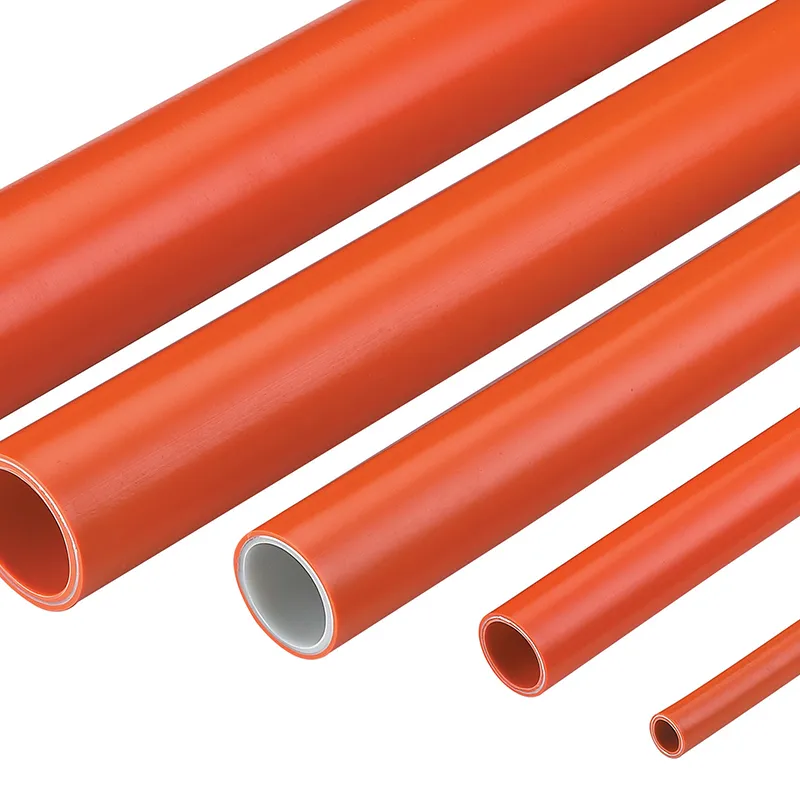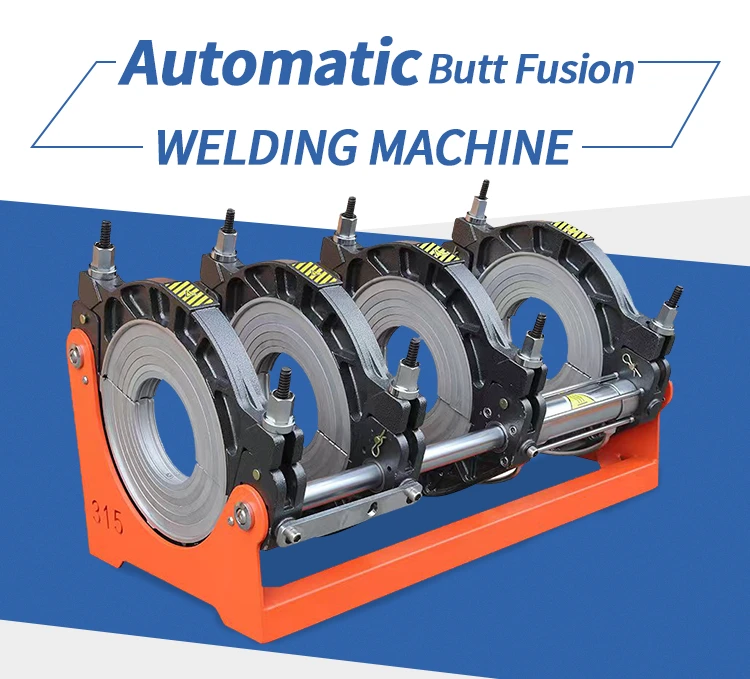A floor heating system is one of the widely used heating methods in the modern construction field, and one of its core components is the pipeline system. In-floor heating systems, PERT floor heating pipes are very popular because of their excellent performance. This article will provide an in-depth introduction to the technical characteristics, advantages, and application fields of PERT floor heating pipes.
Mechanical properties of PE-RT II pipe
| PE-RTⅡ type hydrostatic pressure detection index | Relevant standard requirements | ISO22391Index requirements | |||
| Test conditions | Test results | Test conditions | Index requirements | Test conditions | Index requirements |
| 20℃, 12.0MPa | 11.85h No leakage or breakage | 20℃, 11.4MPa | 1h No leakage or breakage | 20℃, 10.8MPa | 1h No leakage or breakage |
| 95℃, 4.5MPa | >1000h No leakage or breakage | 95℃, 4.4MPa | 22h No leakage or breakage | 9.5℃, 3.9MPa | 22h No leakage or breakage |
| 95℃, 4.3MPa | >1000h No leakage or breakage | 95℃, 4.2MPa | 165h No leakage or breakage | 95℃, 3.7MPa | 165h No leakage or breakage |
| 95℃, 4.0MPa | >1000h No leakage or breakage | 95℃, 4.0MPa | 1000h No leakage or breakage | 95℃, 3.6MPa | 1000h No leakage or breakage |
PE-RT Type I and PE-RT II Pipe Design Stress Table
| Use condition level | Design stress (Mpa) | |
| PE-RT I | PE-RT II | |
| 60℃ hot water system | 3.29 | 3.81 |
| 70℃ hot water system | 2.68 | 3.54 |
| Floor heating system | 3.25 | 3.84 |
| Radiator heating system | 2.38 | 3.1 |
Types of Underfloor Heating Pipes
1. PEX (Cross-linked Polyethylene) Pipes
Advantages: Flexibility, durability, corrosion resistance.
Applications: Widely used in residential and commercial UFH systems.
2. PERT (Polyethylene Raised Temperature) Pipes
Advantages: High-temperature resistance, flexibility.
Applications: Suitable for underfloor heating and radiator systems.
3. PE-RT (Polyethylene of Raised Temperature Resistance) Pipes
Advantages: Combines the properties of PEX and traditional polyethylene.
Applications: Suitable for higher-temperature applications, such as underfloor heating.
4. Multilayer Composite Pipes
Structure: Typically consists of an inner layer of plastic, an aluminum core, and an outer layer of plastic.
Advantages: Combines the strength of metal with the flexibility of plastic.
Applications: Commonly used in underfloor heating and other hydronic heating systems.
5. Copper Pipes
Advantages: Excellent thermal conductivity.
Applications: Less common due to cost but used in some high-end installations.
PERT floor heating pipe technical introduction and application
1. Materials and structure of PERT floor heating pipes
PERT, which stands for polyethylene (PE) cross-linked (X) polyethylene (E) high-density polyethylene (HDPE) composite pipe, is a highly cross-linked polyethylene material. This material has excellent heat resistance, corrosion resistance, and mechanical properties, making it suitable for the complex working environment of floor heating systems.
The structure of PERT floor heating pipes generally includes an inner layer, a middle layer, and an outer layer. The inner layer is made of polyethylene, which has better fluid transmission properties; the middle layer is cross-linked polyethylene, which increases the mechanical strength and heat resistance of the pipe; and the outer layer is usually made of high-density polyethylene, which provides additional protection.
2. Technical features and advantages
2.1 Heat resistance
PERT floor heating pipes have excellent heat resistance and can withstand high operating temperatures, ensuring stable operation in the heating system.
2.2 Flexibility
Due to its material characteristics, PERT floor heating pipes have superior bendability and are suitable for complex construction environments such as bends or narrow spaces.
2.3 Corrosion resistance
Compared with metal pipes, PERT pipes have better corrosion resistance and extend the service life of the pipeline.
2.4 Connection method
The connection methods of PERT floor heating pipes mainly include hot melt connection and mechanical connection, which can be selected according to specific project needs to ensure a firm connection and reliable sealing.
3. Application areas
PERT floor heating pipes are widely used in heating systems of residential buildings, commercial buildings, and industrial facilities. Its flexible bendability makes it particularly suitable for floor heating systems installed in small spaces such as under floors and inside walls. In addition, PERT floor heating pipes are also commonly used in heating, greenhouse planting, and other fields.
4. Installation and maintenance
When installing a PERT floor heating system, professional design and construction standards must be followed. How the pipes are laid, connection techniques, and temperature control are all key considerations. Regular maintenance and inspection can ensure the stable operation of the system for a long time.
PERT floor heating pipe plays an important role in the floor heating system with its excellent performance. Its heat resistance, bendability, and corrosion resistance make it a highly regarded pipe material in modern heating systems. In future construction projects, PERT floor heating pipes will continue to exert their unique technical advantages to provide people with a more comfortable and efficient heating experience.
How to judge the appearance quality of heating tubes?
The color of the heating tube should be consistent and uniform, without decomposition and discoloration. The internal and external surfaces of the heating tube should be smooth and clean, and delamination, pinholes, cracks, bubbles, peeling, marks and inclusions are not allowed. However, slight and local defects are allowed, and the outer diameter and wall thickness do not exceed the allowable tolerances. defects such as scratches, dents, intrusions and spots. Slight straightening and turning marks, fine scratches, oxidation color, darkening, water stains and oil stains may not be used as a basis for scrapping.
What fixing methods can be used for heating tubes?
(1) Use a special fixed plastic card to directly fix the heating pipe on the heat insulation board with a composite surface layer.
(2) Use nylon ties to tie the heating pipe to the steel wire mesh laid on the surface of the insulation layer.
(3) Directly clamp on the special pipe rack or pipe clamp laid on the surface of the insulation layer.
(4) It is directly stuck in the groove formed between the protrusions on the surface of the insulation layer.
What is the spacing between floor heating pipes?
The spacing between floor heating pipes should be calculated and determined based on the heat dissipation of the ground, indoor design temperature, average water temperature and heat transfer resistance. The distance between the pipes should be 100-300mm, the distance between the heating pipe and the inner surface of the exterior wall should be 200-300mm, and the distance between the heating pipe and the inner surface of the bathroom wall should be 100-150mm. The distance between the coils near the window can be appropriately reduced. Generally, the spacing between coils for 16mm pipe diameter is 15cm, and the spacing between coils for 20mm pipe diameter is 20mm.
Is it okay if the length of each loop of the floor heating pipe is not uniform?
The lengths of each loop heating pipe connected to the same distributor and water collector should be as close as possible (the difference does not exceed 15%). If the length of each pipe is too different, it will cause local overheating or underheating. The pipe length along the way should not exceed 120m.
Where floor heating pipes are densely arranged, what issues should we pay attention to?
Near the distributor, water collector and other places where local heating pipes are densely arranged, when the distance between the pipes is less than 100mm, insulation measures such as flexible sleeves should be installed outside the heating pipes, or steel wire mesh should be added in the filling layer to prevent ground cracks.
Where did the impurities in the floor heating pipe come from?
1. Microorganisms. The water contains a large number of microorganisms. Under certain conditions, a large amount of biological slime will be produced and adhere to the non-scaling pipe wall.
2. Calcium and magnesium ions. Water contains calcium and magnesium ions, which will form calcium carbonate and magnesium carbonate when heated. If not cleaned for a long time, they will adhere to the inner wall of the pipeline.
3. External network. If it is central heating, biological slime, impurities, scale, rust, pollutants, etc. in the external pipes may also enter your own pipes.
What is the flow rate of hot water in floor heating pipes?
The flow rate of the heat medium in the floor heating pipe should be 0.35-0.5m/s and should not be less than 0.25m/s.
What are the cleaning methods for floor heating pipes?
Commonly used methods for cleaning floor heating pipes include: filter cleaning, chemical cleaning, projectile cleaning, jet cleaning, and physical pulse cleaning. Filter cleaning and chemical cleaning are often used together with the last three cleaning methods.
1. Filter cleaning. Clean the filter at the front of the water distributor every year before use to ensure the cleanliness of the water pipes and prevent pipe blockage.
2. Chemical cleaning. Put chemicals into the pipes to soak them to achieve the cleaning effect. During the soaking process, some scale and dirt in the pipes will fall off, making the pipes smoother and not blocking the water flow.
3. Projectile cleaning. Projectile cleaning mainly uses the friction between the cleaning projectile and the pipe to achieve the purpose of cleaning. This method is more time-consuming and labor-intensive and can be used selectively.
4. Jet cleaning. When cleaning, use a cleaning agent with a corrosion inhibitor, which can fully dissolve the slime attached to the pipe wall, without causing pollution to the environment or causing corrosion to the floor heating metal pipe fittings, and it must be cleaned thoroughly.
5. Physical pulse wave cleaning. Pulse cleaning uses the vibration wave generated by mixing water and air to impact the heating tube to achieve the cleaning effect. This method is simple and has good cleaning effect.
What are the factors that affect the effective heat dissipation of floor heating?
The heat dissipation of the floor is related to the pipe diameter, ground material and thickness, filling layer thickness, pipe spacing, water temperature and room temperature. In actual engineering, the reduction in heat dissipation caused by the increase in the thickness of the filling layer can be ignored. Floor material and thickness have the greatest impact on effective heat dissipation.
Which parts of floor heating pipes need protection?
1. The main pipeline from the boiler to the sub-water collector;
2. The pipes exposed on the ground at the sub-water collector;
3. Pipes at expansion joints;
4. Pipes passing through walls or places with gaps;
5. The dense area of pipes under the water collector.
What issues should be paid attention to when laying heating pipes?
(1) Pay attention to prevent the steel from being damaged during transportation, and avoid direct sunlight when storing;
(2) The heating tube should not be twisted when placed in a coil;
(3) The exposed opening where the heating pipe is installed and installed should be blocked at any time;
(4) Prevent paint, asphalt or other chemical solvents from contaminating the pipeline during installation.
Will the unreasonable pipe length cause the floor heating to not be hot?
The ideal length of each loop of geothermal pipelines for home renovation is about 65-75 meters. The pipeline is too long and the water resistance increases, which affects the water circulation and causes no heat. At the same time, the length of each loop pipe should be uniform, and the pipe length difference should be controlled within 5 meters. In special cases, it should not exceed 10 meters to ensure that the water flow can enter and exit at the same time to achieve a temperature balance in each heating area. If the pipe length difference is too large, it will This causes a "short circuit" phenomenon that causes the floor to not heat up.
Why is it said that oxygen-blocking floor heating pipes are better?
The presence of oxygen in the pipes will accelerate the aging of floor heating pipes and other components, reducing heat transfer efficiency and service life. It will also promote the growth of microorganisms. More and more microbial corpses will turn into biological slime, causing the heat transfer effect of the pipes to decrease or even become blocked. Therefore, it is recommended to use oxygen barrier tubes.
How to distinguish genuine and fake oxygen-blocking floor heating pipes?
China Construction News gives the following ways to identify genuine and fake oxygen-blocking floor heating pipes:
1. It depends on the appearance. PE-RT pipes or PEX floor heating pipes with an oxygen barrier outer layer have a smooth and shiny appearance.
2. Cut with a blade. Usually the oxygen barrier layer EVOH is not allowed to add color masterbatch. Use a blade to cut the oxygen barrier floor heating pipe. You can see that the outer layer is the natural EVOH layer, the middle layer is the colored glue layer, and the innermost layer is PE-RT or PEX layer. Of course, all natural oxygen barrier layers should not be identified by this method.
3. Put it into water for testing. Some manufacturers use PE instead of EVOH to produce oxygen-blocking PE-RT pipes or PE-X pipes. This type of product can be identified through the principle of "EVOH density is greater than 1, while PE density is less than 1", put the oxygen barrier layer slices into the water and observe whether it floats.
4. It is tested with iodine. If it is a real EVOH barrier material, put iodine on the surface of the oxygen barrier layer, EVOH will dissolve quickly, but non-oxygen barrier materials will not dissolve.
5. It depends on the number of extruders. Since oxygen-blocking floor heating pipes require at least three materials, namely PE-RT or PE-X, oxygen-blocking layer, and glue, the factory must have at least three extruders. If the number of extruders is less than 3, then this factory will definitely not be able to produce oxygen-blocking floor heating pipes.
288.webp)
347.webp)
690.webp)
342.webp)
915.webp)
618.webp)
990.webp)




294.webp)
476.webp)
420.webp)
146.webp)


